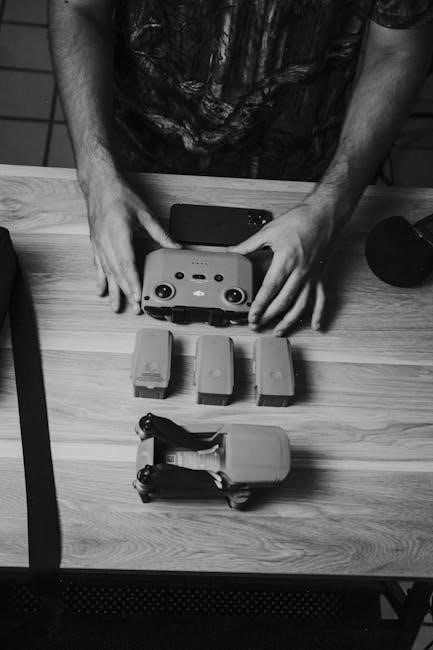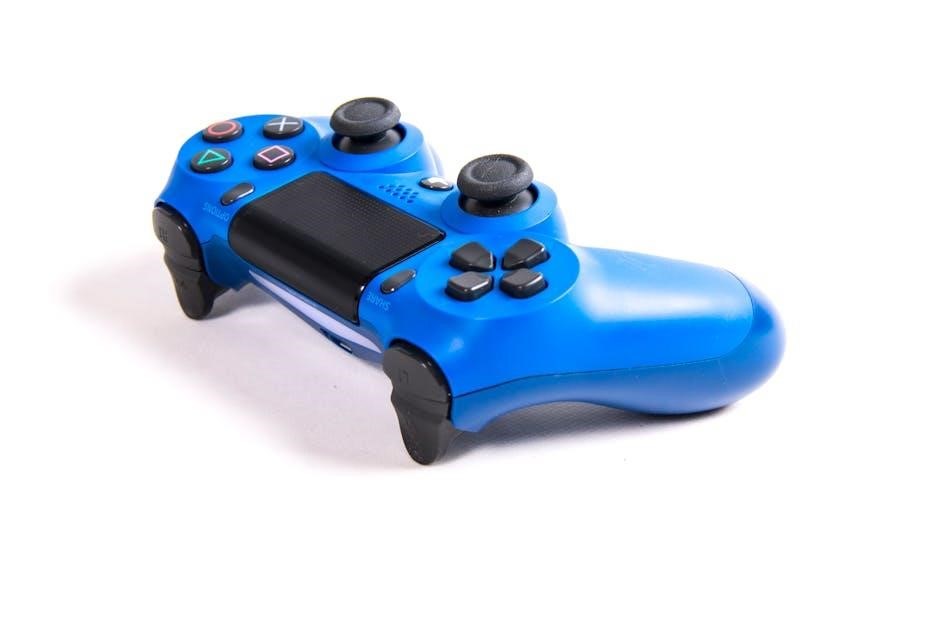The Isuzu Electric Brake Controller is crucial for safe towing with Isuzu vehicles like the MU-X and D-MAX, ensuring smooth trailer braking and efficient control. It offers easy installation with wiring kits tailored for different setups.
1.1 Overview of Electric Brake Controllers
Electric brake controllers are essential for safe and efficient towing, regulating the braking system of a trailer in sync with the towing vehicle. They work by detecting the vehicle’s brake pedal activation and applying proportional or timed braking to the trailer’s brakes. This ensures smooth, controlled stops and reduces the risk of trailer sway or skidding. Modern controllers like the Isuzu Electric Brake Controller offer advanced features such as manual override, LED indicators, and compatibility with various trailer configurations. They are designed to integrate seamlessly with Isuzu vehicles, including the MU-X and D-MAX, providing reliable performance for both on-road and off-road towing scenarios. Proper installation and calibration are critical for optimal functionality.
1.2 Importance in Towing Safety
Electric brake controllers are vital for ensuring towing safety, as they synchronize the braking system of the trailer with the towing vehicle. This synchronization prevents trailer sway, skidding, and loss of control, especially during sudden stops or emergencies. The Isuzu Electric Brake Controller is designed to enhance safety by providing precise and immediate braking responses, reducing the risk of accidents. Its compatibility with Isuzu vehicles, such as the MU-X and D-MAX, ensures reliable performance in various towing conditions. Advanced features like manual override and LED indicators further contribute to safe towing practices, giving drivers greater control and peace of mind on the road.

Key Features and Benefits
Isuzu Electric Brake Controllers offer advanced braking technology, user-friendly interfaces, and compatibility with Isuzu vehicles. They provide precise control, enhancing towing safety and efficiency, with features like manual override and LED indicators for optimal performance.
2.1 Advanced Braking Technology
The Isuzu Electric Brake Controller features proportional braking technology, which synchronizes the trailer brakes with the vehicle’s deceleration. This ensures smooth, balanced stops and reduces wear on both the vehicle and trailer brakes. The controller adjusts braking force proportionally to the vehicle’s speed and pedal pressure, providing precise control. It also includes modes like user-controlled braking for manual adjustments and proportional mode for automatic synchronization. Advanced algorithms enhance responsiveness, especially in emergency situations, while the manual override function allows drivers to apply trailer brakes independently. This technology is designed to adapt to various towing conditions, ensuring safe and efficient braking performance for Isuzu vehicles like the D-MAX and MU-X.
2.2 User-Friendly Interface
The Isuzu Electric Brake Controller is designed with a user-friendly interface, offering intuitive controls for seamless operation. The dash-mounted remote head provides easy access to adjust braking sensitivity and switch modes. A clear LCD display shows real-time braking status, while a simple control knob allows for precise adjustments. The interface is engineered to minimize distractions, ensuring drivers can focus on the road while maintaining control over the trailer brakes. Additional features like preset options and quick-access buttons further enhance convenience. This design ensures that even novice users can operate the system confidently, making it an ideal choice for Isuzu drivers seeking a reliable and straightforward towing solution.
2.3 Compatibility with Isuzu Vehicles
The Isuzu Electric Brake Controller is specifically designed to integrate seamlessly with various Isuzu models, including the MU-X and D-MAX. Its compatibility ensures smooth operation across different vehicle setups, providing reliable braking performance for trailers. The controller works with both 4-way and 7-way trailer connectors, using wiring kits like ETBC7 or 5506 for hardwiring, depending on the existing connector type. This compatibility allows for a straightforward installation process, eliminating the need for extensive modifications. The manual provides detailed instructions tailored to specific Isuzu models, ensuring a perfect fit and optimal functionality. This ensures that Isuzu owners can enjoy safe and efficient towing experiences with minimal effort and maximum reliability.

Choosing the Right Controller
Selecting the ideal Isuzu electric brake controller involves considering trailer weight, vehicle model, and personal preferences. Proportional and time-delayed controllers are the two main options for precise trailer braking control.
3.1 Proportional vs. Time-Delayed Controllers
Proportional controllers adjust braking force based on the vehicle’s deceleration, providing smooth and synchronized stops. They are ideal for heavy trailers and frequent towing. Time-delayed controllers apply brakes after a set delay, offering simplicity but less precision. Proportional systems are recommended for larger loads and regular use, while time-delayed controllers are cost-effective for lighter trailers and occasional towing. The choice depends on trailer weight, towing frequency, and personal preference. Both types require proper installation and setup for safe operation. Understanding these differences ensures optimal braking performance and towing safety.
3.2 Factors to Consider in Selection
When selecting an Isuzu Electric Brake Controller, consider the trailer weight and number of axles to ensure compatibility. The vehicle’s towing capacity and wiring setup (4-way or 7-way connector) are crucial for proper installation. Choose between proportional or time-delayed braking based on towing frequency and trailer type. Additionally, consider user-friendly interfaces, manual override functionality, and LED indicators for ease of operation. Compatibility with Isuzu models like the D-MAX or MU-X is essential. Finally, assess installation complexity and warranty options. These factors ensure a safe and efficient towing experience tailored to your needs.
Understanding the Controller’s Operation
The Isuzu Electric Brake Controller operates by connecting to the vehicle’s brake pedal, activating trailer brakes proportionally or with a time delay. It uses wiring to link the vehicle’s electrical system, enabling manual override and LED status alerts for safe towing control.
4.1 Connection to Brake Pedal
The Isuzu Electric Brake Controller connects directly to the vehicle’s brake pedal to monitor braking activity. This connection allows the controller to sense when the driver presses the brake pedal and send proportional signals to the trailer brakes. The installation involves tapping into the brake pedal’s wiring harness to ensure seamless communication. This setup ensures that the trailer brakes engage simultaneously with the vehicle’s brakes, providing synchronized stopping power. Proper wiring is essential to avoid signal interference or delays. Once connected, the controller offers precise control over braking force, enhancing towing safety and stability. This direct link is a critical component for effective trailer braking system operation.
4.2 Wiring and Electrical Requirements
Proper wiring and electrical connections are essential for the Isuzu Electric Brake Controller to function correctly. The controller requires a direct connection to the vehicle’s brake pedal wiring to monitor braking activity. A wiring kit, such as the ETBC7 or 5506, is necessary for installation, depending on whether the vehicle has a 4-way or 7-way trailer connector. The positive wire must be connected to the vehicle’s battery, while the negative wire should be grounded to ensure proper electrical flow. Additionally, the controller must be wired to the trailer’s braking system through the appropriate connectors. Correct wiring prevents electrical interference and ensures safe, reliable operation. Always refer to the provided wiring diagrams for accurate connections.
4;3 Manual Override Function
The Manual Override Function allows drivers to apply the trailer brakes independently of the vehicle’s braking system. This feature is particularly useful in emergency situations or when additional control over the trailer’s braking is needed. To activate the manual override, drivers typically press a dedicated button or switch on the controller, which sends an electrical signal to the trailer’s brakes. This function ensures safer towing by providing immediate control, especially when driving downhill or in slippery conditions. The manual override complements the proportional braking technology, offering an extra layer of safety and control. Always ensure the manual override is used judiciously to avoid sudden or excessive braking, which could lead to loss of trailer stability.
4.4 Proportional Braking Technology
Proportional Braking Technology ensures that the trailer brakes engage in sync with the vehicle’s braking intensity. This advanced system uses a sensor to monitor the vehicle’s deceleration and applies the same level of braking force to the trailer. Unlike time-delayed controllers, proportional braking provides smooth and balanced stops, reducing wear on both the vehicle and trailer brakes. It is especially beneficial for heavy or unevenly loaded trailers, as it prevents sudden jerking or skidding. The Isuzu Electric Brake Controller’s proportional technology enhances towing safety and stability, making it ideal for drivers who tow frequently or in varying road conditions. This feature is a key reason why Isuzu controllers are preferred for their reliability and precision in towing scenarios.
4.5 LED Indicators and Alerts
LED indicators and alerts on the Isuzu Electric Brake Controller provide real-time feedback about the system’s status. The LED lights illuminate to show power status, active braking, or error conditions. For example, a steady green light may indicate normal operation, while a flashing red light could signal a problem such as a short circuit or disconnected trailer brakes. These visual cues help drivers quickly identify issues and ensure safe towing. The manual override function also triggers an LED indicator, confirming when manual control is active. Additionally, some models include audible alerts for critical errors, enhancing safety by ensuring the driver is always informed. These features make the Isuzu Electric Brake Controller user-friendly and reliable for towing applications. Proper monitoring of these indicators is essential for maintaining safe and efficient braking performance;

Installation Guide
Installation involves mounting the main unit, wiring the controller, and calibrating the system. Use wiring kits like ETBC7 or 5506 for compatibility with Isuzu models. Follow the manual for proper setup.
5.1 Pre-Installation Checklist
Before installing your Isuzu Electric Brake Controller, ensure you have the correct wiring kit (ETBC7 or 5506) and consult the vehicle’s manual. Gather tools like screwdrivers and wire strippers. Verify the trailer connector type (4-way or 7-way) and check the vehicle’s towing capacity. Ensure the battery is fully charged and disconnect the negative terminal for safety. Confirm the controller is compatible with your Isuzu model (e.g., MU-X or D-MAX). Review the wiring diagram provided with the kit. Familiarize yourself with the installation steps and ensure all components are included. Plan the mounting location for the controller and remote head for easy access. Follow safety guidelines to avoid electrical issues during the process.
5.2 Step-by-Step Installation Process
Begin by identifying the correct wiring kit (ETBC7 for 4-way or 5506 for 7-way connectors). Connect the brake controller to the vehicle’s brake pedal wiring and ensure proper power and ground connections. Use the provided wiring diagram to link the controller to the trailer connector. Mount the remote head in an accessible location. Perform active calibration by driving the vehicle and applying the brakes to sync the controller with the trailer’s braking system. Test the setup to ensure proportional braking. Refer to the Isuzu Electric Brake Controller Manual for specific calibration instructions and safety precautions. Ensure all connections are secure and double-check the wiring to avoid electrical issues. Complete the installation with a final test of the braking system to confirm proper functionality. Always follow manufacturer guidelines for a safe and accurate setup.
5.3 Wiring Diagrams and Connections
Refer to the wiring diagram provided in the Isuzu Electric Brake Controller Manual to ensure accurate connections. Use the ETBC7 kit for 4-way trailers or the 5506 kit for 7-way setups. Connect the positive terminal of the controller to the vehicle’s battery and the negative terminal to a suitable ground point. Attach the brake pedal wire to the controller’s input terminal and ensure the trailer connector is properly linked. Consult the diagram to identify the correct wiring colors and connections for your specific Isuzu model. Secure all wires to prevent damage and ensure reliable operation. Double-check the connections to avoid electrical malfunctions. Follow the manual’s guidelines for a safe and efficient setup. Proper wiring ensures optimal braking performance and safety while towing.
5.4 Mounting the Remote Head
Mount the remote head of the Isuzu Electric Brake Controller in a convenient location on your dashboard or center console. Ensure it is easily accessible and visible for operation. Use the provided screws to secure the remote head firmly to the surface. Avoid areas that may be exposed to excessive heat or water. Connect the remote head wiring to the main controller unit, following the wiring diagram in the manual. Ensure the connection is secure to prevent signal loss. Test the remote head after installation to confirm proper functionality. Refer to the manual for specific mounting recommendations tailored to your Isuzu model. Proper installation ensures easy control and reliable operation of the brake controller. Always follow the manufacturer’s guidelines for a safe and efficient setup.
5.5 Active Calibration Process
The active calibration process ensures your Isuzu Electric Brake Controller works seamlessly with your vehicle and trailer. Start by connecting the trailer and ensuring all wiring is secure. With the engine running, press and hold the manual override button to begin calibration. Slowly accelerate to 10-15 mph while maintaining light brake pedal pressure. The controller will automatically adjust to synchronize braking forces. Repeat this process at least three times to ensure precise calibration. After completion, test the brakes at various speeds to confirm smooth operation. Refer to your Isuzu model’s manual for specific calibration steps, as procedures may vary slightly. Proper calibration ensures safe and efficient towing performance. Always follow manufacturer guidelines for optimal results.

Operating the Controller
Operating the Isuzu Electric Brake Controller involves adjusting braking force sensitivity, using manual override, and switching between braking modes for optimal towing performance and safety.
6;1 Adjusting Braking Force Sensitivity
Adjusting braking force sensitivity ensures the trailer brakes respond appropriately to the towing vehicle’s deceleration. Use the control knob to fine-tune the sensitivity, ensuring smooth braking without over- or under-reacting. Proper adjustment prevents trailer skidding or jerking, enhancing towing stability. Test the setup by braking gently and observing the trailer’s response. If the trailer brakes too aggressively, reduce sensitivity; if they’re too weak, increase it. Always refer to the Isuzu Electric Brake Controller manual for specific calibration steps and safety guidelines to ensure optimal performance and safety while towing.
6.2 Using Manual Override
Manual override allows drivers to apply the trailer brakes independently of the vehicle’s brakes, providing extra control in emergencies or when adjusting braking balance. Locate the manual override button or switch on the Isuzu Electric Brake Controller. Pressing it activates the trailer brakes directly, enabling precise control. Use this feature cautiously, as it overrides the proportional braking system. Always release the override after use to resume normal operation. Consult the manual for specific instructions on activating and deactivating this feature safely and effectively to ensure proper trailer braking performance and maintain towing stability.
6.3 Switching Between Braking Modes
Switching between braking modes on the Isuzu Electric Brake Controller allows drivers to adapt to different towing conditions. The controller typically offers a proportional mode, which applies brake force in proportion to the vehicle’s deceleration, and a manual or user-controlled mode. To switch modes, locate the mode selector button or dial on the controller. Pressing or turning it will cycle through available modes, often indicated by LED lights or a display. Ensure the mode matches your towing needs for optimal safety and control. Always refer to the manual for specific instructions on mode selection and operation to maintain proper braking performance and towing stability. This feature enhances flexibility in various driving scenarios.

Maintenance and Troubleshooting
Regular maintenance ensures the Isuzu Electric Brake Controller functions optimally. Check wiring connections, clean corrosion, and verify brake light signals. Refer to the manual for troubleshooting common issues.
7.1 Routine Maintenance Checks
Regular maintenance is essential for optimal performance of the Isuzu Electric Brake Controller. Start by inspecting the wiring for signs of wear or corrosion, ensuring all connections are secure. Clean the terminals and connectors to prevent electrical issues. Check the brake light circuit to ensure it’s functioning correctly, as the controller relies on this signal to activate the trailer brakes. Verify the battery connection to avoid power interruptions. Finally, review the manual for specific recommendations tailored to your Isuzu model. By following these steps, you can prevent common problems and maintain reliable braking control while towing.
7.2 Diagnosing Common Issues
Diagnosing issues with the Isuzu Electric Brake Controller involves checking for error codes, wiring problems, or sensor malfunctions. Start by consulting the manual for specific diagnostic steps, as some models display error codes like “S.H.” or “5.H.” Inspect the wiring for damage or loose connections, ensuring the brake pedal sensor is functioning correctly. If the trailer brakes fail to activate, verify the manual override function and test the brake light circuit. For persistent issues, reset the controller as outlined in the manual. If problems persist, contact a certified technician or Isuzu specialist for professional assistance. Regular troubleshooting ensures reliable performance and safe towing operations.
7.3 Resetting the Controller
Resetting the Isuzu Electric Brake Controller is essential to resolve software glitches or recalibrate settings. Start by ensuring the vehicle and trailer are stationary with the parking brake engaged. Locate the reset button, typically found on the controller or outlined in the manual. Press and hold the button for 5-10 seconds until the LED indicators flash, signifying a factory reset. After resetting, recalibrate the controller by driving slowly and applying the brakes gently. Test the braking system to ensure proper function. If issues persist, refer to the manual or contact a professional. Regular resets help maintain optimal performance and towing safety.

Safety Precautions and Best Practices
Always follow the manual and ensure the controller is installed correctly. Avoid sudden stops and never exceed your vehicle’s towing capacity. Regular inspections and proper wiring are essential for safe operation.
8.1 Essential Safety Measures
Safety is paramount when using the Isuzu Electric Brake Controller. Always ensure the vehicle and trailer are properly connected, and the controller is installed correctly to avoid malfunctions. Never exceed the recommended towing capacity of your Isuzu vehicle, as this can lead to loss of control. Regularly inspect the wiring and connections to prevent electrical issues. Use the manual override feature judiciously and only in emergencies. Keep the trailer brakes well-maintained and ensure proper alignment of the trailer with the towing vehicle. Adhere to all local towing regulations and guidelines provided in the manual to ensure a safe towing experience.
8.2 Emergency Braking Procedures
In the event of an emergency, the Isuzu Electric Brake Controller’s manual override feature allows direct control of the trailer brakes. Engage the manual override by firmly pressing the button on the controller to activate the trailer brakes independently of the vehicle’s brakes. Ensure the vehicle is traveling at a safe speed and maintain control of the steering wheel. Avoid sudden movements that could cause loss of traction or trailer sway. If the trailer begins to skid, release the manual override briefly to allow the brakes to reset. Always follow proper towing practices and maintain a safe distance from other vehicles to minimize the risk of emergencies. Regularly test the manual override function to ensure it operates correctly.
8.3 Towing Best Practices
Proper towing practices are essential to ensure safety and efficiency when using the Isuzu Electric Brake Controller. Always load your trailer evenly and within the manufacturer’s weight limits. Secure the trailer to the vehicle using a sturdy hitch and ensure all connections are tight. Before towing, perform a pre-trip check to verify that all lights, brakes, and wiring are functioning correctly. Adjust the brake controller sensitivity to match the weight and type of trailer being towed. Maintain a safe following distance and reduce speed when driving in adverse weather conditions. Avoid sudden acceleration or braking, as this can cause trailer sway. Regularly inspect the trailer tires and brakes to ensure they are in good working condition. By following these best practices, you can ensure a safe and trouble-free towing experience.
The Isuzu Electric Brake Controller enhances towing safety and efficiency through proper installation, adjustment, and maintenance. Adhering to best practices ensures reliable performance and optimal braking control.
9.1 Summary of Key Points
The Isuzu Electric Brake Controller is a vital component for safe and efficient towing, ensuring proper trailer braking synchronization with the vehicle. Compatibility with models like the D-MAX and MU-X makes it a tailored solution. Installation requires specific wiring kits, such as the ETBC7 or 5506, as Isuzu vehicles are not factory wired for electric brake controllers. Choosing between proportional or time-delayed controllers depends on towing needs and preferences. Proper installation, adjustment, and maintenance are crucial for optimal performance. Regular checks and troubleshooting ensure reliability. By adhering to guidelines and best practices, users can maximize safety and efficiency while towing with their Isuzu vehicle.
9.2 Final Thoughts on Safety and Efficiency
The Isuzu Electric Brake Controller stands out as a reliable solution for enhancing towing safety and efficiency. By ensuring proper synchronization between the vehicle and trailer brakes, it minimizes risks and provides a smoother towing experience. Proper installation, adjustment, and maintenance are critical to optimize performance. Selecting the right controller type, whether proportional or time-delayed, tailored to specific towing needs, further enhances safety. Adhering to guidelines and best practices ensures reliability and efficiency. Ultimately, the Isuzu Electric Brake Controller is an essential component for anyone seeking to tow securely and confidently, making it a vital investment for safe and efficient towing operations.

Frequently Asked Questions
Common queries include choosing the right controller type, installation steps, and troubleshooting issues like error codes. Understanding compatibility and wiring requirements is essential for optimal performance and safety.
10.1 Common Queries and Solutions
Users often ask about selecting the correct brake controller type, installation processes, and troubleshooting common issues like error codes or braking malfunctions. Compatibility with Isuzu models and wiring requirements are frequent topics, as well as understanding proportional vs. time-delayed braking modes. Solutions include consulting vehicle-specific manuals, using wiring kits like ETBC7 or 5506, and ensuring proper calibration. Resetting the controller or checking connections often resolves operational issues. Ensuring the right fit for trailer weight and type is crucial for safe and efficient towing. Proper installation and maintenance can prevent many common problems, enhancing overall towing safety and performance.
10.2 Troubleshooting Tips
- Flashing error codes: Codes like S.H. or 5.H. often indicate issues with the trailer brakes or wiring. Check connections and ensure proper installation.
- No braking function: Verify the manual override and ensure the controller is calibrated correctly. Consult the manual for reset procedures if needed.
- Uneven braking: Adjust the braking force sensitivity and ensure proportional braking is enabled for smoother stops.
- Wiring issues: Inspect all connections, especially the brake pedal wire and battery terminals, to ensure they are secure and free from corrosion.
- Calibration problems: Perform the active calibration process again, ensuring the vehicle is on level ground and the trailer is properly connected.
